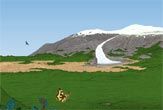- Sep 9, 2022
- 11,805
- 5,361
- 938
Fair explanation. It was established long ago that the Arctic once was tropical and they found evidence of enormous mosquitos that once lived there.which is "peanuts" and is subject to wild fluctuations as these go off...
Earth ice
90% on land mass Antarctica
7% on land mass Greenland
0.3% on Ellesmere Island
The rest, all 2.7%, is on mountains, small islands within 600 miles of a pole, and sea ice...
Sea ice is peanuts...








